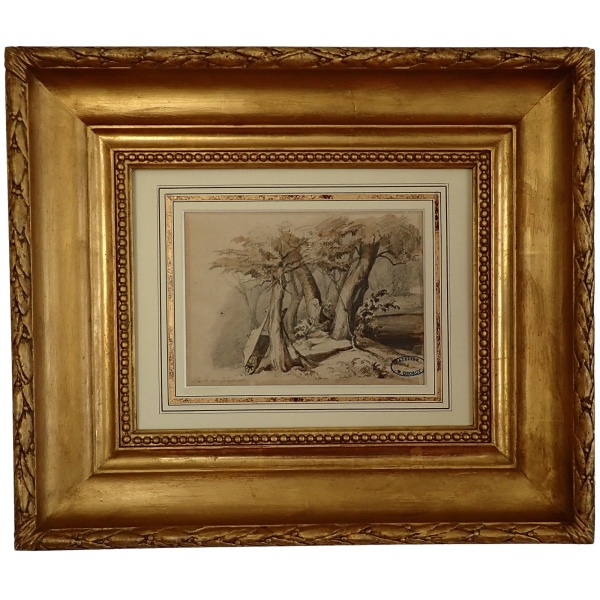A Charming Ink Drawing Of The Park in Weimar by W Georgy

A Charming Ink and Watercolor Drawing Of the Park in Weimar by German draftsman, Wilhelm GEORGY.
In this charming depiction the viewer is treated to a bucolic exterior scene with a few trees intertwined and a gardener’s wheelbarrow.
The drawing is situated by Georgy on the left lower corner and bears the stamp of his atelier in the right-hand lower corner.
The fascination of Georgy with this lovely Park is understandable as it was one of Weimar’s most beloved sites and today is a Unesco World Heritage site.
In the late 18th and early 19th centuries the small Thuringian town of Weimar witnessed a remarkable cultural flowering, attracting many writers and scholars, notably Goethe and Schiller. This development is reflected in the high quality of many of the buildings and of the parks in the surrounding area.
The 48-hectare park on the Ilm is a unique landscape garden on the edge of Weimar’s old town. Duke Carl August and Johann Wolfgang Goethe realized their horticultural ideas here. They created a walk-in work of art with varied landscapes, park architecture and seating areas, which to this day serves recreation, education and aesthetic enjoyment of nature.
The creation of the Park on the Ilm is closely connected with Goethe’s life and work in Weimar. In 1776, Duke Carl August gave the poet a house with a garden, known today as the Goethe Garden House located in the Park on the Ilm.
In the following period, Goethe and Carl August together planned the first grounds in the new English taste between the town, the palace and Goethe’s garden house. Thus, starting in 1778, the design of the western Ilm with its wooded backdrops, walkways and park architecture was created. The construction of the Roman House, completed in 1797, marked the high point of the park’s development after the large-scale expansion of the park to the south and the integration of older palace gardens. With its underground tunnel system, the Erlebnis Parkhöhle, the park can be explored from a completely different perspective. The entrance to the twelve-meter-deep cave is located in the immediate vicinity of the Liszt House between the steep slope to the Ilm River and Belvedere Avenue.
After losing some of its attraction to the masses in the early 20th century, it was re visited and once gained famed at the end of 1970.
Wilhelm Georgy, the draftsman, was a student of Friedrich Preller the Elder in Weimar and excelled as an illustrator.
He was born in Magdebourg in 1819 and passed away in Weimar in 1887
Georgy first lived and worked in Leipzig, where he produced woodcuts as well as drawings.
Georgy’s accurately drawn works, which testify to a profound study of nature, were of no small importance for late Romantic German book illustration.
His drawings can be found in several Museums of which the collection of the Morgan Library in New York.
The Frame measures 9 1/2 ” x 11 ”
The Drawing measures 3 1/2 ” x 4 5/8 ”
Germany 19th Century c.Reference number: R-403
Click here to print.
go back
